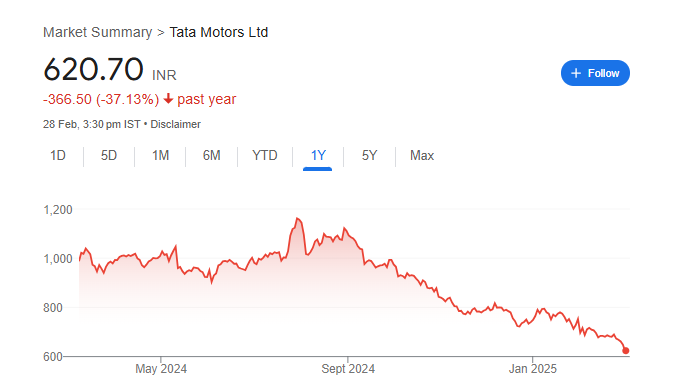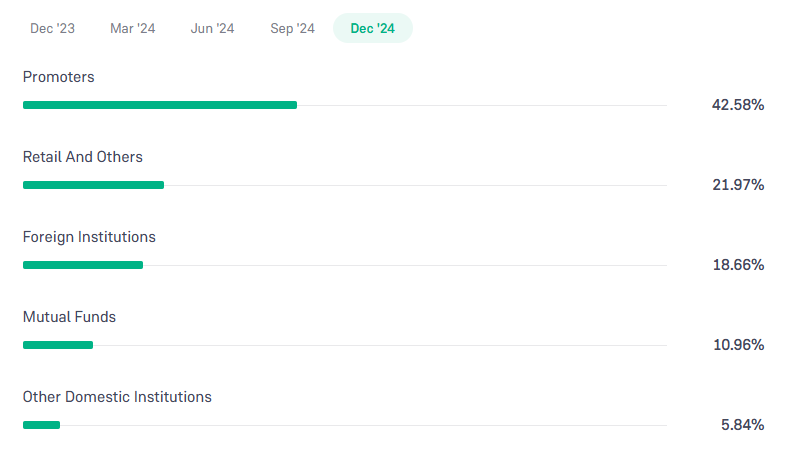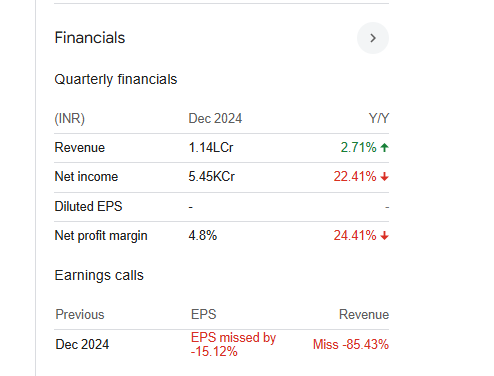Tata Motors is one of India’s most trusted automobile brands, known for its strong presence in passenger, commercial, and electric vehicles. As the company focuses on innovation, electric mobility, and global expansion, investors are keenly watching its share price target. Tata Motors Share Price on 2 March 2025 is 620.70 INR. This article will provide more details on Tata Motors Share Price Target 2025, 2026 to 2030.
Tata Motors Company Info
- Founded: 1945, Mumbai
- Founder: J. R. D. Tata
- Headquarters: Mumbai
- Number of employees: 91,496 (2024)
- Parent organization: Tata Group
- Revenue: 4.44 lakh crores INR (US$56 billion, 2024)
- Subsidiaries: Jaguar Land Rover, Tata Technologies
Tata Motors Share Price Chart

Tata Motors Share Price Details
- Today Open: 645.00
- Today High: 645.00
- Today Low: 618.45
- Mkt cap: 2.28LCr
- P/E ratio: 5.45
- Div yield: 0.48%
- 52-wk high: 1,179.00
- 52-wk low: 618.45
Tata Motors Shareholding Pattern
- Promoters: 42.58%
- Foreign Institutions: 18.66%
- Mutual Funds: 10.96%
- Retails and others: 21.97%
- Domestic Institutions: 5.84%

Tata Motors Share Price Target Tomorrow 2025, 2026 To 2030
- 2025 – ₹1180
- 2026 – ₹1540
- 2027 – ₹1954
- 2028 – ₹2330
- 2029 – ₹2856
- 2030 – ₹3260
Tata Motors Share Price Target 2025
Tata Motors share price target 2025 Expected target could be ₹1180. Tata Motors, one of India’s leading automobile manufacturers, has been experiencing strong growth due to its innovation and expanding market presence. Several factors will influence its share price target in 2025. Here are six key growth drivers:
1. Electric Vehicle (EV) Expansion
Tata Motors is a leader in India’s electric vehicle market with its Tata Nexon EV and Tigor EV. Increasing EV demand, government incentives, and infrastructure development will boost sales and revenue.
2. Strong Domestic and Global Demand
Tata Motors’ passenger and commercial vehicle segments have seen strong demand in both domestic and international markets. Expanding its global presence, especially in key markets like Europe and Africa, will contribute to revenue growth.
3. Performance of Jaguar Land Rover (JLR)
Jaguar Land Rover, a subsidiary of Tata Motors, plays a crucial role in the company’s profitability. New model launches, luxury EV transitions, and demand recovery in key markets like the US and China will impact Tata Motors’ financial performance.
4. Technological Advancements and Innovation
Tata Motors is investing in advanced technologies such as connected vehicles, autonomous driving, and alternative fuel options. These innovations will enhance the company’s competitive edge and attract more buyers.
5. Government Policies and Support
Favorable policies related to electric vehicles, emission norms, and manufacturing incentives will help Tata Motors grow. Government push for EV adoption and local production (Make in India) can further strengthen its market position.
6. Cost Management and Supply Chain Stability
Efficient cost control, better raw material sourcing, and a stable supply chain will help Tata Motors maintain profitability. Overcoming global semiconductor shortages and reducing input costs will be crucial for sustained growth.
Tata Motors Share Price Target 2030
Tata Motors share price target 2030 Expected target could be ₹3260. Tata Motors is poised for long-term growth with its strong presence in passenger vehicles, commercial vehicles, and electric mobility. Several factors will influence its share price target by 2030. Here are six key growth drivers:
1. Dominance in Electric Vehicle (EV) Market
Tata Motors is leading India’s EV revolution. With growing demand, government incentives, and advancements in battery technology, the company’s EV segment is expected to contribute significantly to revenue and profitability.
2. Expansion of Jaguar Land Rover (JLR)
Jaguar Land Rover’s transition to electric and sustainable mobility will be crucial. If JLR successfully expands its luxury EV lineup and captures global market share, it will enhance Tata Motors’ overall financial performance.
3. Global Market Penetration
Tata Motors is expanding its presence in international markets, including Europe, Africa, and Southeast Asia. Strengthening its global footprint will drive higher sales and revenue growth.
4. Adoption of Advanced Technologies
Investments in autonomous driving, AI-powered vehicle systems, and alternative fuel technologies (such as hydrogen fuel cells) will keep Tata Motors competitive in the evolving automobile industry.
5. Government Regulations and Support
Favorable policies related to electric vehicles, clean energy, and manufacturing incentives will benefit Tata Motors. A strong push for sustainable mobility and infrastructure development will provide further growth opportunities.
6. Strong Commercial Vehicle Segment
Tata Motors is a leader in commercial vehicles, and continued demand for trucks, buses, and electric commercial vehicles will drive steady growth. Fleet electrification and smart mobility solutions will further strengthen this segment.
Financials Statement Of Tata Motors
| (INR) | 2024 | Y/Y change |
| Revenue | 4.38T | 26.58% |
| Operating expense | 1.57T | 22.31% |
| Net income | 313.99B | 1,200.55% |
| Net profit margin | 7.17 | 924.29% |
| Earnings per share | 84.43 | 3,833.91% |
| EBITDA | 485.43B | 123.09% |
| Effective tax rate | -13.78% | — |


Read Also:- Suzlon Share Price Target Tomorrow 2025, 2026 To 2030

